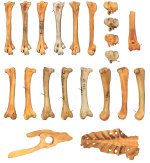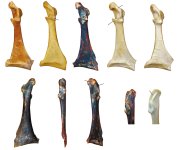Fred Ruhe
Well-known member

Nikita V. Zelenkov, 2022
The Fossil Stone Shelduck (Tadorna petrina) and a Shoveler (Spatula praeclypeata sp. nov.)-The Oldest Early Pleistocene Ducks (Aves: Anatidae) from Crimea
Paleontological Journal. 56 (6): 92–104. (Russian edition)
Abstract: https://www.elibrary.ru/item.asp?id=49546707
Based on materials from the Taurida Cave (central part of the Crimean Peninsula, 1.9–1.5 Ma), the oldest remains of anseriform birds for the Early Pleistocene of Northern Black Sea area are described. A fragmentary skeleton of a shelduck (Tadornini) is attributed to the fossil Stone Shelduck Tadorna petrina Kurochkin, 1985, originally described from the Upper Pliocene of Transbaikalia and morphologically close to modern Ruddy Shelducks T. ferruginea. This is the oldest find of the Ruddy Shelducks phylogenetic lineage in Europe, shedding light on the paleobiogeographical distribution and evolution of the group in the Late Cenozoic. Tadorna petrina is considered as the most likely stem member of the clade, which includes the modern species T. ferruginea, T. cana, T. tadornoides, and T. variegata. The migration of representatives of this group to Australia was apparently associated with the existence of the savannah belt in the Early–Middle Pleistocene in Southeast Asia. A new fossil Shoveler Spatula praeclypeata sp. nov. from Taurida Cave is the oldest find of this lineage in the fossil record and is considered as a stem taxon of the living species S. smithii, S. rhynchotis, and S. clypeata. The faunistic association of the Ruddy Shelduck and a shoveler is characteristic of many Middle and Late Pleistocene avifaunas of Europe; Crimean finds testify in favor of its more ancient and, probably, eastern origin.
Remark: I will come back on this paper when the English edition is published.
Enjoy,
Fred
The Fossil Stone Shelduck (Tadorna petrina) and a Shoveler (Spatula praeclypeata sp. nov.)-The Oldest Early Pleistocene Ducks (Aves: Anatidae) from Crimea
Paleontological Journal. 56 (6): 92–104. (Russian edition)
Abstract: https://www.elibrary.ru/item.asp?id=49546707
Based on materials from the Taurida Cave (central part of the Crimean Peninsula, 1.9–1.5 Ma), the oldest remains of anseriform birds for the Early Pleistocene of Northern Black Sea area are described. A fragmentary skeleton of a shelduck (Tadornini) is attributed to the fossil Stone Shelduck Tadorna petrina Kurochkin, 1985, originally described from the Upper Pliocene of Transbaikalia and morphologically close to modern Ruddy Shelducks T. ferruginea. This is the oldest find of the Ruddy Shelducks phylogenetic lineage in Europe, shedding light on the paleobiogeographical distribution and evolution of the group in the Late Cenozoic. Tadorna petrina is considered as the most likely stem member of the clade, which includes the modern species T. ferruginea, T. cana, T. tadornoides, and T. variegata. The migration of representatives of this group to Australia was apparently associated with the existence of the savannah belt in the Early–Middle Pleistocene in Southeast Asia. A new fossil Shoveler Spatula praeclypeata sp. nov. from Taurida Cave is the oldest find of this lineage in the fossil record and is considered as a stem taxon of the living species S. smithii, S. rhynchotis, and S. clypeata. The faunistic association of the Ruddy Shelduck and a shoveler is characteristic of many Middle and Late Pleistocene avifaunas of Europe; Crimean finds testify in favor of its more ancient and, probably, eastern origin.
Remark: I will come back on this paper when the English edition is published.
Enjoy,
Fred
Last edited:






